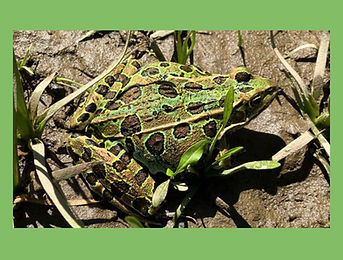Atlantic Coast Leopard Frog
Lithobates kauffeldi
Conservation Status:
State Status: Under Review (NatureServe, 2024)
Global Assessment: Least Concern (IUCN, 2021)
Listen to call:
(Eric Bartkowski, 2023)
Description
The Atlantic coast leopard frog is a newly described species, being discovered to be separate from its close relative, the Northern leopard frog, in 2014 (Feinberg, 2024). They can range in color from dull shades of brown to green, with two light ridges running down their backs that start behind the eyes. This species gets its name from the dark spots covering their sides and back, resembling a leopard. They have white undersides and can grow to about 3 inches long (Quinn, 2020).
Habitat
Atlantic coast leopard frogs can most often be found in wetland areas, such as marshes or floodplains. There are only a few populations located in Connecticut.
Behavior
The breeding season occurs in the spring. At night, groups of males will call from within shallow water to attract females (Feinberg, 2024). Atlantic Coast leopard frogs will eat insects and other small invertebrates. These are easily frightened frogs, and will escape quickly if they feel threatened.
Range


Atlantic Coast Leopard Frog
Photographed by John Michael Arnett
Often Confused with

Northern Leopard Frog
Photographed by Eric M. Powell
These two types of leopard frogs are very visually similar and were only recently described as two distinct species. Atlantic coast leopard frogs are duller in color, ranging from browns to muted greens. Northern leopard frogs are a brighter green and have larger spots. These two differences can be seen in the images above.

Atlantic Coast Leopard Frog
Photographed by John Michael Arnett
Often Confused with

Pickerel Frog
Photographed by Stephanie Campbel
A big difference between these species is the pattern of their spots. Pickerel frogs have two rows of rectangular spots running down their back, while leopard frogs have circular spots that appear randomly. The differences in their spotting pattern can clearly be seen in the images above. Pickerel frogs also tend to have snouts that are more blunt and yellow coloring on the underside of their hind legs.
References
Eric Bartkowski. (2023, April 2). Atlantic Coast Leopard Frog Calls. Youtube. https://www.youtube.com/watch?v=kgpFxDLu4ZI.
iNaturalist. (2024). Observations. California Academy of the Sciences / National Geographic Society. https://www.inaturalist.org/observations?place_id=49&taxon_id=424676.
International Union for Conservation Of Nature and Natural Resources. (2021, May 21). Atlantic Coast Leopard Frog. https://www.iucnredlist.org/es/species/79079709/119001176.
Klemens, M. W. et al. (2021). Conservation of Amphibians and Reptiles in Connecticut. Department of Energy and Environmental Protection. https://ctdeepstore.com/products/conservation-of-amphibians-reptiles-in-connecticut.
NatureServe. (2024, November 1). Lithobates kauffeldi. https://explorer.natureserve.org/Taxon/ELEMENT_GLOBAL.2.941975/Lithobates_kauffeldi.
Quinn, D. P. (2020). Atlantic Coast Leopard Frog. Connecticut Herpetology. https://www.ctherpetology.com/atlantic-coast-leopard-frog.
Feinberg, J. (2024). Atlantic Coast Leopard Frog - Rana kauffeldi. Yale Peabody Museum. https://peabody.yale.edu/explore/collections/herpetology/guide-amphibians-reptiles-connecticut.
Page updated November 14, 2024
